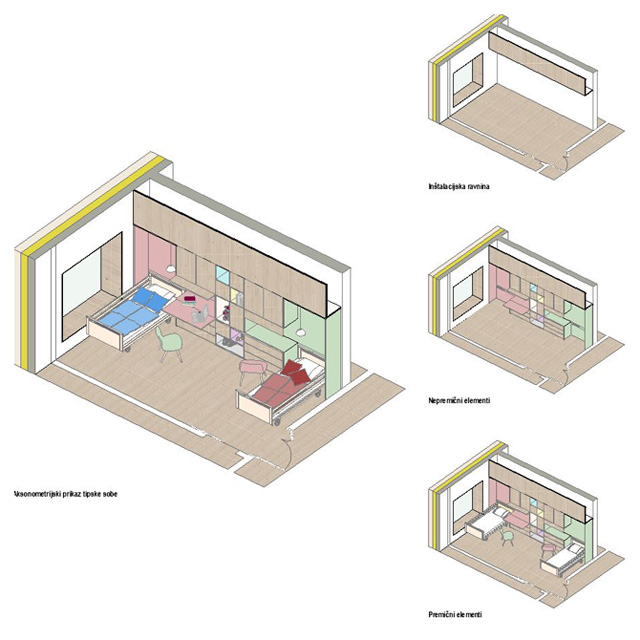Children rehabilitation center for chronic diseases
The new department of the Children’s Rehabilitation Center for Chronic Diseases is located in Šentvid pri Stični. Šentvid is part of the historical region of Lower Carniola known as Stari trg, where the parish church is dedicated to Saint Vitus (Slovene: sveti Vid). The site for the new hospital department is located in the existing park, surrounded by Oak and Plane trees as well as Maple trees. The new hospital is designed for Children and youth with special health care needs, partly for patients with chronic conditions in pediatric intensive care and partly for those with motor disorders. The concept of the new hospital is trying to change the notion of the hospital as an isolated building. From this larger context, the contemporary hospital typology is redesigned in order to provide a better sensory experience for patients. New typology, such as human-related quality of space, light, human-scaled materials, acoustics, and diverse types of social spaces, follows the principles of domestic places as a »new home«, composed with an attentive approach, and form pleasant buildings to reduce stress in children patients. The social spaces of the new hospital take into account the residential alternative, in contrast to the notorious anomie of endless hospital corridors or a repetitious set of sterile therapy rooms, isolated from social areas. The social spaces are the most important parts of children’s hospital facilities because they enable maximum interaction with both parents and others. Namely, when a child is hospitalized, the entire family becomes included in the treatment, which means that the hospital becomes a second home for the whole family. The purpose of the new children’s hospital is to design an institution that is family-oriented. The new design is the result of the research, where we analyzed the connection between the public and the intimate space and developed the object that combined both of these contents/features. The design conceptualizes many types of social spaces filled with elements and factors that fit different children’s groups and communities. Its design, in terms of legibility of layout, the hierarchy of the parts, and the capacity for growth and change, refers to the domestic place building as a paradigm, most evident in the ‘hospital street’ – the ‘main artery’, speaking as a metaphoric reference. Spatial disposition inside of each department, undertakes the type of a residential unit where the corridor becomes the living room with a library, place of worship, media corner, play station, and a central canteen room that transforms into a single family dining room. Communication corridors become the living area from where each patient can access their individual room. The design of a Hospital is a well-deliberated hierarchy from public to intimate space. The building has subdivided departments that classify the children patients into smaller groups, like family units. Inside every double-bed family unit, there is also an ingenious, intimate place on an extended windowsill as a treehouse. Treehouses are intimate corners for individual child in order to provide a place for retreat, a place to find their own peace and their contact with nature. The unique character of these places appeals not only to childhood memories but also fulfills desires for an intimate meeting place, romanticism, and a unique experience.













